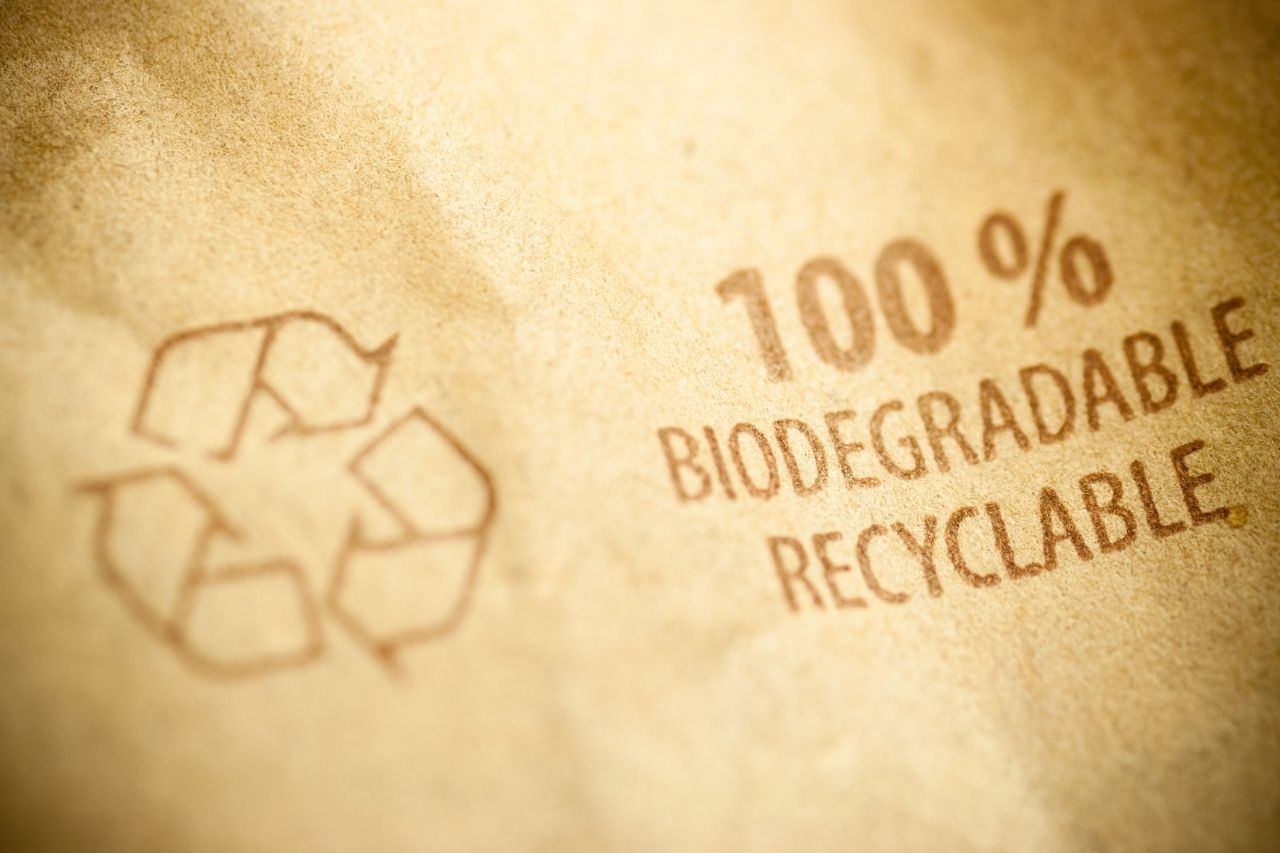What is biodegradation?
Microorganisms such as bacteria or fungi can decompose almost everything from your kitchen wastes to crude oil. Through a series of processes, microbes can digest the complex molecules that make up the wastes and convert them into simpler forms like water, carbon dioxide, methane, etc.
Biodegradable materials generally include all materials that are of natural origin. All materials that can be decomposed naturally by microorganisms are called biodegradable materials. Examples are agricultural products, paper, cotton, etc. When biodegradable materials are disposed of, microbes convert them into their basic components, recycling them back to nature.
Manure, compost, and biogas are useful products of biodegradation.
Non-biodegradable materials, on the other hand, are materials of synthetic origin. Examples include plastics, glasses, paints, metals, etc. Natural agents alone cannot decompose non-biodegradable materials. They remain in the environment for a long time as solid wastes, releasing toxic chemicals and gases, causing pollution.
Hence, biodegradable materials are preferable over their synthetic counterpart. The problems posed by wastes generated from non-biodegradable materials are massive. Consequently, consumers and manufacturers across many fields are becoming increasingly eco-conscious. Worldwide, responsible manufacturers and scientists are exploring greener alternatives like bamboo, mycelium, seaweed, plant-based plastics, etc.
Microorganisms are introduced to wastes, where they do not naturally grow. This process is called bioremediation. Introducing bioengineered microbes facilitates the digestion of toxic wastes, eventually removing harmful chemicals and pollutants from the soil. In phytoremediation, plants take the place of microbes to bind and clean up contaminants in the ground.
We cannot emphasize the importance of biodegradation enough. It is nature’s way of cleaning up the Earth and keeping it healthy and sustainable. Without it, the Earth would be a massive pile of wastes, reeking of garbage and unsuitable for living.
The process of biodegradation
The process of biodegradation comprises of three stages- biodeterioration, bio fragmentation, and assimilation.
The first stage, bio-deterioration, is the weakening of the general structure of wastes. Natural elements like light, temperature, air, soil, and chemicals play an essential role. As the chemical and mechanical system gets weakened, the wastes are ready for the next stage.
In the next stage, microbes breakdown the complex molecules into their units called monomers and some intermediate compounds called oligomers. Fragmentation is the most crucial stage of all, which we shall discuss in detail. These simpler compounds then go through the third stage, that is, assimilation into the microbial cells.
Biofragmentation of molecules depends on the type of microbes digesting the waste. Some microbes digest wastes in the presence of oxygen, while some do so without oxygen. Decomposition in the presence of oxygen is called aerobic digestion, and biodegradation without oxygen is called anaerobic digestion.
Aerobic biodegradation
The aerobic microbes, also called aerobes, break the complicated bonds of the organic molecules with oxygen. Oxygen is essential for this process as aerobes have an oxygen-based metabolism. In this type of reaction, the aerobes use enzymes to break the chemical bonds of polymers. This reaction occurs in the cytoplasm. Then they carry the smaller fragments to the mitochondria and oxidize them to produce energy.
The process of aerobic biodegradation is very efficient. It occurs rapidly, and no toxic gases or residues are left behind. Microbes can completely digest the wastes, reducing the solid matter by about 50 percent.
Anaerobic biodegradation
Anaerobes, on the other hand, digest wastes in the absence of oxygen. The anaerobic process is much slower as it follows a more complicated process.
In anaerobic digestion, aerobes break the complex materials into simple sugars, amino acids, and fatty acids. These products are then digested by two types of bacteria – first by the acetogens and then the methanogens.
Acetic acid-producing bacteria, the acetogens, digest these simple materials and convert them into carbon dioxide, hydrogen, and a large amount of acetic acid.
Methanogens then digest the resulting products to produce methane gas, carbon dioxide, and water.
Both aerobic and anaerobic reactions result in the same end-products, namely Carbon dioxide, water, some residue, and new biomass. The difference is, anaerobic reactions produce additional gas methane, which is a potent greenhouse gas.
Landfills as an energy source
With the average American producing 1,130 pounds of wastes a year, we have saturated landfills across the country with municipal wastes. According to EPA, Municipal solid wastes (MSW) landfills are the largest source of human-related methane emissions in the US. They accounted for approximately 15.1 % of these emissions in 2018.
When we deposit wastes in landfills, it undergoes aerobic degradation. Initially, landfills emit very little methane. However, they establish anaerobic conditions in less than a year, and methane-producing bacteria steadily generate methane.
Landfill gas comprises 50% carbon dioxide, 50% methane, and a small amount of other organic compounds. These gases are serious pollutants, with methane gas 28 to 36 times more potent than carbon dioxide to cause global warming.
Instead of allowing them to escape, landfill projects can trap them to produce superior quality energy. As a healthy alternative to non-renewable energy sources, these gases are useful in myriad ways.
There are many positive aspects of harvesting landfill gas.
Landfills are teeming with wastes, and we generate more daily. Hence, these wastes are a renewable source of energy. Since landfills are polluted and uninhabited areas, investment for energy projects is comparatively lesser. The energy harnessed from landfills can replace non-renewable sources of energy such as fossil fuels. And substituting fossil fuels with landfill gas will significantly reduce emissions of harmful pollutants like sulfur dioxide, nitric oxides, and particulate matter.
Setting up landfill energy projects improves the quality of air. Estimates say that landfill energy projects successfully trap about 60-90 percent of methane emitted from landfills. The percentage, of course, depends on the equipment and effectiveness of the system. When toxic gases are collected, it can no longer travel to the atmosphere causing local smog and global warming. Landfill projects also conserve land by reducing solid wastes and increasing space.
Apart from benefitting the environment, landfill gas also generates revenue for the government from the gas sale. Plus, it creates job opportunities for the community. Engineers, construction firms, equipment vendors, and power users benefit from landfill gas projects. Because of these benefits, the government is encouraging partnerships and new ventures.
How is landfill gas used?
About 18 percent of landfill gas generated at the site is piped directly to customers near the plants. Landfill gas is directly used in combustion equipment, auto manufacturing, chemical production, etc., where little filtration of gas is required. Food and beverage processing, cement and brick, wastewater treatment, and steel production are other examples where LFG is useful.
About 10% of landfill gas is converted into Renewable Natural Gas. The plants reduce Carbon dioxide, oxygen, and nitrogen gas, increasing methane gas content to produce RNG. A superior quality fuel, RNG can replace fossil fuels. They are transported as pipeline quality gas for use at homes. Power plants also convert landfill gas into compressed natural gas and liquefied natural gas.

About 72 percent of the current landfill energy projects are generating electricity. Combined heat and power projects produce both electricity and thermal heat in the form of hot water or steam.
According to EPA, as of August 2020, 565 LFG energy projects in the US are in operation. Besides, they have 475 landfills listed as promising candidates for setting up projects. The government is making efforts to encourage landfill projects which are beneficial in every way. It is the best way to deal with mounting problems related to environmental health. Setting up landfill gas projects is not just helpful; it is necessary.
What is the difference between biodegradable, compostable, and OXO biodegradable?
Even though we have discussed enough wastes, some confusion remains around the type of waste materials.
“Aren’t biodegradable and compostable materials the same thing?” many people ask. They aren’t the same things.
All materials degrade sooner or later. Some materials take weeks to break down into their fundamental components, while others might take decades or even centuries. So, technically all things are biodegradable, even the most notorious waste materials.
Biodegradation is the breakdown and conversion of wastes into their fundamental components. Composting, on the other hand, is the process of recycling organic matter so you can reuse it. For instance, you can collect your organic kitchen wastes and allow it to decompose. After some time, you get to use the recycled wastes as manure and fertilizer. This is an example of composting.
Composting is a rapid process, and it has several benefits. Composting adds nutrients to the soil and improves its quality. Soil with compost retains more moisture and can suppress plant diseases.
According to EPA estimates, about 20-50 percent of the wastes generated by the average American are compostable. Composting organic scraps will reduce garbage at landfills and clear up a lot of space. The production of methane, a potent greenhouse gas, will be reduced. Otherwise, a large amount of methane will remain in the atmosphere, contributing to global warming. Methane gas has a long lifespan of 12 years, another reason why landfill projects must capture it.
Composting natural wastes can improve air quality and increase biodiversity by promoting the growth of healthy microorganisms. It enhances the quality of soil, prevents soil erosion, and much more. It is the cheapest method of disposal and the safest too.
However, composting means something different from the biodegradation of wastes in your backyard when applied to industrial products. When a company calls its products compostable, they can be composted but only under some conditions. You must dump compostable waste materials into industrial composting facilities. They will not naturally decompose on their own. They have to be placed under the right conditions to deteriorate and disintegrate into simpler forms.
Hence buying a compostable product doesn’t always mean you are making an environmentally safe choice. Unless you dispose of it in a designated composting facility, it will stay on for a long time as wastes. You must ensure the waste management processes are in place so that your scraps find their way back to the Earth.
OXO Biodegradable materials

OXO biodegradable materials are entirely different from compostable and biodegradable materials though we use the terms synonymously. OXO Biodegradable materials are made using metals and salts, which help them decompose quickly. They break down into smaller fragments that no longer visually pollute the environment. However, resulting components are still subject to microorganisms for further degradation.
Specific additives containing metals like cobalt, manganese, iron, etc., are added to plastics before converting to final products. Traditional plastics such as polyethylene, polypropylene, polystyrene, polyvinyl chloride, etc., are turned into OXO biodegradable products by adding additives. When you dispose of these materials, certain factors like UV radiation or heat trigger chemical reactions. As a result, the reactions fragment the polymer chains. In this way, OXO biodegradable materials are broken down quickly and are no longer an eyesore. Microorganisms feed directly on the fragments and convert them into carbon dioxide, water, and biomass.
OXO biodegradable materials have their benefits. They are strong and durable. Unless exposed to radiation and heat over a prolonged period, they have a long shelf life. They look no different from regular plastics in their print, texture, or strength. They can also be recycled, unlike many degradable plastics, which are non-recyclable. Plus, their degradation does not produce the potent greenhouse gas methane.
However, biodegradation of fragmented plastics may take several years or decades. Further, metals in OXO plastics add more pollutants to the environment. Thus, you cannot fully trust claims that OXO biodegradable materials are environmentally safe.
To reduce such claims made by many companies, the Federal Trade Commission in 2012 revised the green guide. It advised that biodegradable claims are accepted if companies have scientific evidence that their product will completely decompose within a short period under conventional disposal methods. Since then, FTC has cracked down on many misleading claims.
Only with proper knowledge can we choose our products wisely and get to be responsible buyers. I hope this article helps all eco-conscious consumers to live sustainably and contribute to a greener Earth.




0 Comments